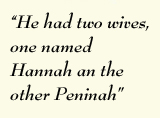Hannah’s Prayer
Introduction
The story of Hannah is found in the Book of Samuel which follows the Book of Judges in the biblical cannon. Whereas Judges paints a picture of moral chaos and political decadence, the Book of Samuel introduces us to the prophet Samuel, chosen to anoint the first kings of Israel, and segues to an era of relative stability in Israelite history. The narrative bears witness to God’s transformative power, which created a new historical possibility where none existed before.
But the story does not begin with a prophet or a king—it starts in the home of a provincial family in Ramatayim Zofim faced with serious domestic challenges:
There was a man from Ramatayim Zofim, in the hill country of Ephraim, whose name was Elkanah son of Jeroham son of Elihu son of Tohu son of Zuph, an Ephraimite. He had two wives, one named Hannah and the other Peninah; Peninah had children, but Hannah was childless. This man used to go up from his town every year to worship and to offer sacrifice to the Lord of Hosts at Shiloh. Hophni and Phinehas, the two sons of Eli, were priests of the Lord there.
(1Sam 1:1-3)
References:
Dobrinsky, Herbert. A Treasury of Sephardic Laws and Customs: The Ritual Practices of Syrian, Moroccan, Judeo-Spanish and Spanish and Portuguese Jews of North America, New Jersey, 1988.
Glis, Yaakov. The Customs of Eretz Israel, (in Hebrew), Jerusalem, 1994
Levine, Yael. “‘And Hannah Prayed’- The Biblical Portion of Hannah in Liturgy.” In Masechet, 4 (2005).
Mutzafi, Benzion. Responsa Mevasseret Tzion, (in Hebrew), Part 1, Jerusalem, 2005
Verstil, Asher (ed.), Of the customs of the Tribes of Israel, (in Hebrew), Jerusalem, 1996))
